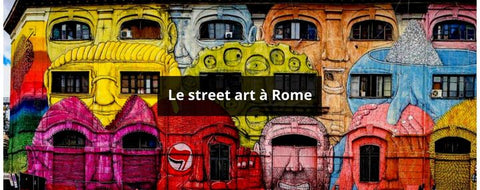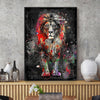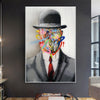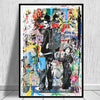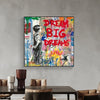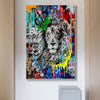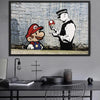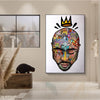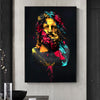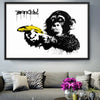
Who is Basquiat?
Are you curious to know who Basquiat was? Well, that's perfect, because we're passionate about Basquiat's work! Although some details of his life are shrouded in mystery, we've demystified many of them over the years.
Basquiat was a very famous American painter in the 1980s. A pioneer of the Underground movement and a leading figure of the Neo-Expressionist movement, he enjoyed a meteoric career, producing over two thousand works. Jean-Michel Basquiat died at the age of 27 from a speedball overdose.
In this article, you will learn about:
- His origins and the beginnings of his career as an artist
- His work and his rise in the world of contemporary art
- The main causes of his death and the legacy he left behind.
By the end of this article, the life of Jean-Michel Basquiat will hold no more secrets for you. You'll know exactly how the American artist was born, lived, and died. Let's discover it together without further ado.

I) Who is Jean Michel Basquiat?
From his childhood to his early career and his rise in the world of New York street art , we take you on a journey through the life of the man who is now considered a legend of contemporary urban art.
A) Basquiat, a child prodigy
Jean-Michel Basquiat was born on December 22, 1960, in Brooklyn, to a Haitian father named Gérard and a Puerto Rican mother named Matilde. A precocious child, he displayed uncommon aptitudes in languages and art. He learned to read and write at the age of four and was fluent in three languages by the age of eight: English, French, and Spanish.
His passion for drawing prompted his mother to take him on regular trips to the Museum of Modern Art in New York, encouraging him to develop his artistic talent. Hospitalized in 1968 following a car accident, Jean-Michel received as a gift from his mother Gray's Anatomy of the Human Body, as well as Leonardo da Vinci's anatomical plates. These works would influence the early stages of his career.

At the age of 15, Basquiat enrolled at the prestigious Saint Ann's private art school, where he met and befriended the graffiti artist Al Diaz . He dropped out of school at 16, left the difficult circumstances of his family home, and wandered the streets of Greenwich Village. It was there that he discovered the underground scene.
B) Basquiat, a rising figure in New York Street Art
It was in the street that the career of the famous street artist began in 1976.
He works in a clothing store and makes a living selling postcards and T-shirts that he paints himself. With his friends Al Diaz and Shannon Dawson , Michel Basquiat starts by doing graffiti in the streets and near the galleries of Manhattan, which he tags under the mysterious pseudonym SAMO .
The concept and his works quickly sparked public curiosity and attracted attention. Cultural media outlets like The Village Voice dedicated an article to him in 1978. Working first in a collective, then solo, Basquiat very quickly became an artistic figure in the East Village .

He took a detour into music, founding the noise rock band Gray in 1979. A year later, he was rediscovered as part of a group exhibition at the Times Square Show in 1980, alongside neo-expansionist artists such as Susan Rothenberg and Julian Schnabel. The exhibition was a resounding success and marked his rise to the fame he would experience throughout the 1980s.
C) SAMO, the signature graffiti of the street artist
SAMO©, an acronym for " Same old shit ", is the pseudonym that Basquiat and Al Diaz used to tag their graffiti across the walls of southern Manhattan, the East Village and the subway trains of New York.
Supposed to represent the "Same old shit", the street artist has made it his signature, accompanying it with logos and short texts communicating messages of criticism towards the art world and society.
Following a disagreement with his friend Al Diaz, he ended the SAMO project with his laconic message " SAMO IS DEAD ." The message appeared on the walls of several buildings in the city center as well as the facades of several art galleries in SoHo.

II) Works by Basquiat
A) Basquiat conquering the art market
From the streets of the East Village to the biggest avant-garde exhibitions in America, then the world, Jean-Michel Basquiat made a meteoric rise in the world of contemporary art and lived a career full of success.
Following the Times Square Show, the artist's first solo exhibition was organized in New York with the help of gallery owner Annina Nosei . Subsequently, he collaborated on the Transavanguardia Italia/America group exhibition alongside artists of the Neo-Expressionist movement such as Keith Haring , Julian Schnabel , and Barbara Kruger , among others.
Top art critics praised the style and originality of his painting, as well as his ability to fuse words, animals, symbols, and objects of all kinds into a work of art. René Ricard, in fact, lauded him in his article "The Radiant Child," published in Artforum magazine in 1981, giving a significant boost to the young artist's career.
Continuing his rise, the 23-year-old street artist participated in the 1983 Whitney Museum of American Art Biennial. His very first exhibition in Africa took place at the French cultural center in Ivory Coast in 1986 with the participation of Bruno Bischofberger and his friend Jennifer Good, Andy Warhol and Basquiat, a historic collaboration!
Basquiat's life and career were also marked by his collaboration with the renowned pop artist Andy Warhol . They met in the early 1980s and forged a deep and sincere friendship. This led to a collaboration from 1984 to 1986 during which the two artists created over a hundred paintings together, including Ten Punching Bags (Last Supper) , Eiffel Tower , and Untitled (50 – Dentures) , among others.
Overall, their collaboration was not well received by the public, and even less so by critics. It ended in 1986, a year before Warhol's death.
III) The causes of Basquiat's death
Although his fame transcended him, Basquiat's life was short-lived. As quickly as he became famous and wealthy, the artist came crashing back down to earth, the victim of an overdose.
A) A street artist in the spotlight
The fame and celebrity acquired by Jean-Michel Basquiat did not have only positive effects on the artist. The popularity of his works and their commercialization allowed him to quickly earn enormous sums of money , but he struggled to manage his fortune.

Moreover, the opulence in which he now lives has an impact on his social relationships. Becoming paranoid, he isolates himself from the world. Furthermore, he struggles to integrate and assimilate the social codes of the elitist contemporary art circles he begins to frequent. In addition, the increased commercial and marketing pressure on his work at this stage of his life will gradually lead him to drug addiction.
B) Basquiat and drugs
Basquiat's personal problems emerged and developed as gradually as the street artist's popularity. Most concerning of all was his drug addiction . His wealth facilitated his access to some of the most harmful drugs, such as cocaine and heroin.
Many of his friends, including Andy Warhol, tried their best to wean him off excessive consumption . Unfortunately, Warhol's death from a heart attack in 1987 was a tragedy for Basquiat. Desperate to break free from his addiction , he left New York for Hawaii in 1988. Upon his return a few months later, he claimed to have overcome his addiction, a claim that later proved false.

C) Death of Basquiat
Jean-Michel Basquiat died of a heroin and cocaine overdose on August 12, 1988 in his Great Jones Street studio in New York at the age of 27.
In just 10 years of his career, Basquiat produced over 1,500 drawings and 800 paintings ( reproductions of these paintings are available in our online store). More than 30 years after his death, the artist returned to the forefront of the art world with the 2017 auction of his skull-shaped painting Untitled (1980) for a record $110.5 million.
As you have seen, Basquiat was a young avant-garde painter with a very rich body of work. Although his career was short, he played an important and historic role in the rise of the cultural and artistic scene in downtown New York and the Neo-Expressionist movement .
You now have a good understanding of the life of this legendary artist. From now on, you'll be able to easily discuss contemporary art with street art enthusiasts.
See you soon.
The Lofty Trend Team






